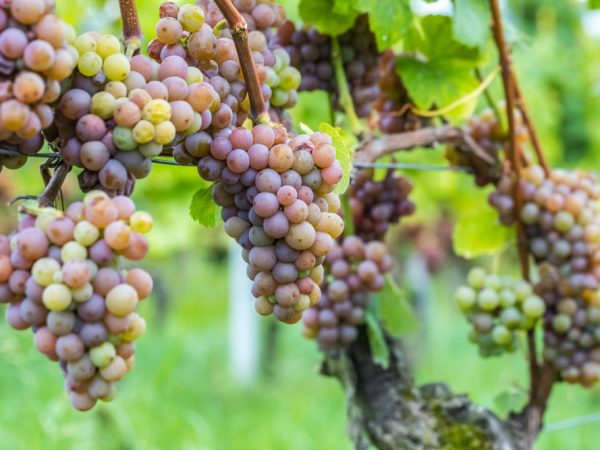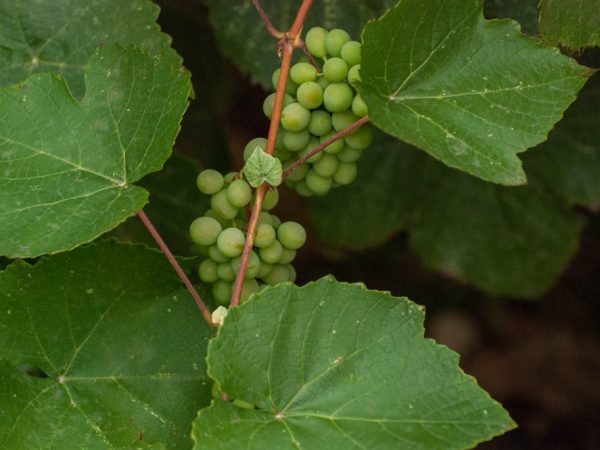Description of grapes Nakhodka
The best option for making raisins is Nakhodka grapes. It is characterized by good shelf life and fast drying. If you pay attention to the exactingness of this variety to the peculiarities of care, it is really possible to grow high-quality products.

Description of grapes Nakhodka
General characteristics of the plant
The culture belongs to the early varieties. Full ripening of the fruits occurs within 3 months after flowering. The plant begins to bear fruit 3 years after planting.
Features of the bush
The bush is characterized by active growth. It grows up to 3 m in height. The main trunk and shoots are powerful, which allows them to quickly acquire a tree-like structure. Flowers are white, predominantly female flowering type. The leaves are wide, five-lobed, dark green. The surface of the sheet is smooth and dense.
Fetal parameters
Large berries reach a weight of 10 g. The peel is so dense that when dropped or overripe, the fruits do not crack. The shape of the berries is oval. The color is pale pink. Bunches are conical, each weighing up to 1.5 kg.
According to the description, Nakhodka raisins grapes give a good harvest. Gardeners collect up to 7 kg of high-quality products from each bush.
The pulp is firm, but juicy. The fruit tastes sweet, without acid and bitterness. There are no seeds, so children are allowed to eat them. Shelf life is up to 3 months.
Correct cultivation
Boarding times vary by location. In the central and southern regions of the country, seedlings are planted at the end of March. In the northern regions, planting is carried out at the end of May. The planting area should be well lit. If the plant receives the right amount of sunlight, its taste will be sweeter.
Fertile loamy lands that conduct moisture well are chosen as the soil. The acidity of the soil should not be more than 4%. If the cultivation is carried out in sandstones, 1 bucket of humus or compost is introduced for each square meter before planting. When planting in dense clay, 1 sq. m make 2 buckets of humus and compost.
The depth of the planting pit should be 1 m. The width of each side of the square hole is 80-90 cm. A drainage is installed at the bottom, which will protect the root system from closely located groundwater. Dry tree branches or broken brick are used as drainage. The top layer of earth is mixed with 1 bucket of compost, the resulting mixture is filled ½ the hole.
Grape seedlings are placed at an acute angle to the ground and sprinkled with earth tightly. After that, each plant is watered with 10 liters of warm water. A high (up to 120 cm) support is placed next to grapes of the Nakhodka raisins. The distance between the bushes should be 1.5 m, and between the rows - 2.5 m.
Care rules

Taking care of plants is not difficult
Caring for this variety consists of watering, pruning, weeding and fertilizing.
Features of irrigation and weeding
Watering should be done infrequently, at intervals of 20 days.The roots of the raisins of the Nakhodka variety are located deep underground, so they are able to independently take moisture from the lower layers of the soil. No more than 15 liters of water is poured under each bush. An excess of moisture leads to the complete death of the bush due to the risk of root rot. Weeding and removal of weeds is carried out 2-3 days after watering grapes of the Nakhodka raisins.
The optimum daytime temperature for grapes of the Nakhodka variety is 20 ° C-27 ° C. At night it is allowed to lower it to 15 ° C-18 ° C. If there is a risk of frost, it is better to cover the culture with dense protective films (made of polyethylene or agrofibre), although the culture is able to withstand temperatures as low as -20 ° C.
Fertilization
Top dressing is carried out in several stages.
- During the period of active growth of the bush, a solution of ammonium nitrate is introduced (40 g per 10 l of water). At least 15 liters of the drug are poured under each bush.
- When forming bunches, top dressing is carried out with superphosphate (60 g per 10 l of water). 10 liters of solution for each bush.
- Grape discovery is a variety that needs a fruit ripening stimulator, therefore, to accelerate fruiting, 10 liters of potassium nitrate solution (60 g per 10 liters of water) are added under each bush.
Pruning
In the first year after planting, the shoots should remain intact. In the second year, it is allowed to cut them, leaving no more than 3 eyes on each. In the third year, pruning is not carried out completely. Shoots are shortened by 40 cm. Only diseased and damaged areas of the bush are completely removed.
Diseases and pests
The main diseases to which the plant is exposed are powdery mildew, black spot, anthracnose and gray rot. Spraying with “Khomus” preparation (30 g per 10 l of water) helps to get rid of powdery mildew and gray rot, and Regent's solution (50 g per 10 l of water) helps to get rid of black spot. In the fight against anthracnose, a manganese solution is used (3 g per 10 l of water) or Topaz (30 g per 10 l of water).
Of the pests, the Nakhodka is affected by the leafworm, scabbard and cushion. To fight these insects helps the drug "Quadris" (20 g per 10 liters of water).
Preventive measures
Prevention involves following all the rules of care. If the crop is planted at the correct distance, it receives the right amount of sun and water, it will not be barred by weeds, pests and diseases will not infect the plant.
Conclusion
The find is an undemanding variety. To grow quality products with good presentation, they monitor the development of the plant. Each of its changes indicates the need for one or another action to improve the quality of the bush.


